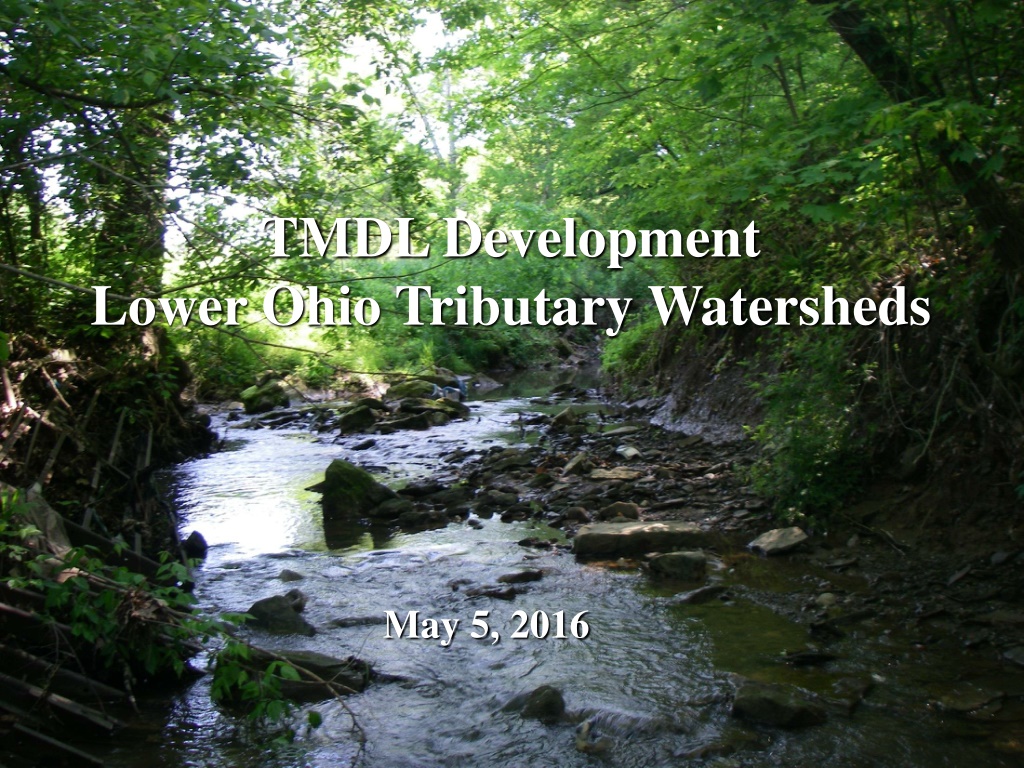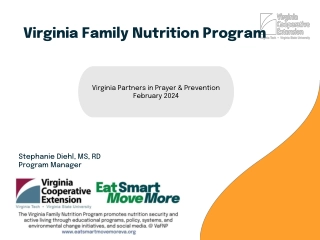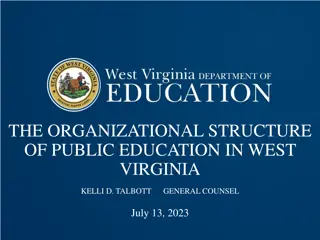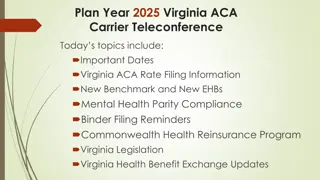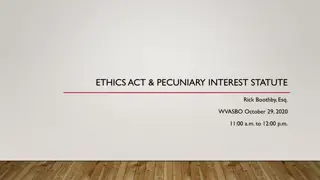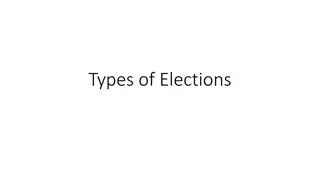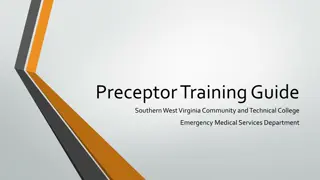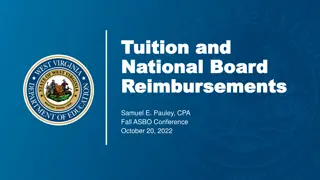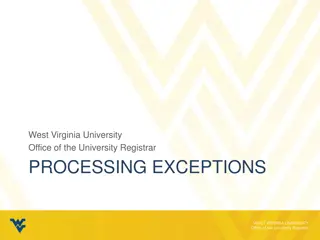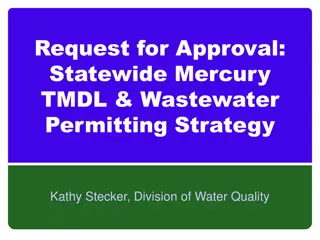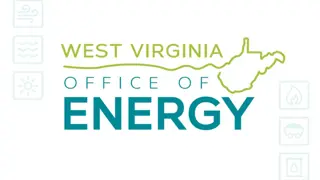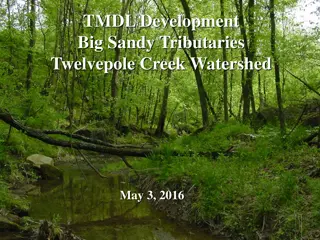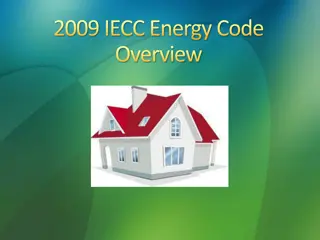Understanding TMDL Development in West Virginia
Explore the TMDL development process in West Virginia, including water quality standards, impaired waters, and the role of TMDLs in restoring water quality. Learn about the criteria for impaired streams, numeric and narrative standards, and the assessment methods used to identify sources of impairment.
Download Presentation

Please find below an Image/Link to download the presentation.
The content on the website is provided AS IS for your information and personal use only. It may not be sold, licensed, or shared on other websites without obtaining consent from the author. Download presentation by click this link. If you encounter any issues during the download, it is possible that the publisher has removed the file from their server.
E N D
Presentation Transcript
TMDL Development Lower Ohio Tributary Watersheds May 5, 2016
Agenda Background information on Water Quality Standards, impaired waters and TMDLs Brief history of WV TMDL development Overview of WVDEP s TMDL process Discussion of local impaired waters and their TMDL timeline Pre-TMDL Monitoring Plan for local waters Discussion Free form questions and answers
Whats a TMDL? Total Maximum Daily Load How much of a pollutant/s a stream can receive and remain healthy TMDL is a pollutant budget prescribes reduction in pollutants, where needed, that result in the restoration of an impaired stream TMDL development is required by Clean Water Act for all impaired streams
Whats an impaired stream? Stream that doesn t meet water quality standards West Virginia Water Quality Standards are codified in 47 CSR 2 Standards include designated uses for WV waters and water quality criteria to protect those uses Criteria can be numeric or narrative Impaired streams (streams that are not meeting criteria) are on the 303(d) List
Numeric Criteria Fecal Coliform Bacteria Human Health Protection (Water Contact) 200 counts/100ml as a monthly geometric mean No more than 10% of samples in a month exceed 400 counts/100ml Total Iron HumanHealth/Aquatic Life Protection 1.5 mg/l as a 4 day average concentration (warmwater) Not to be exceeded more than once every 3 years Not to exceed 1.5 mg/l (Public Water)
Narrative Criteria Biological Impairment Conditions Not Allowable in State Waters (47 CSR 2-3.2i) .....no significant adverse impact to the chemical, physical, hydrologic or biological components of aquatic ecosystems shall be allowed.
Previous 47 CSR 2 - 3.2.i Assessment Based on Benthic Macroinvertebrates West Virginia Stream Condition Index (WVSCI) Standardized method for assessing benthic macroinvertebrates (aquatic bugs) WVSCI stream scores normalized to 0 - 100 range Streams scoring less than the 60.6 threshold value labeled as impaired and placed on the 303(d) list Streams listed as impaired slated for TMDLs Biologically Impaired streams evaluated for source/s of impairment during the TMDL development process (Stressor Identification Process)
2012 Legislative Changes Senate Bill 562 passed by the 2012 West Virginia Legislature amended the WV Water Pollution Control Act Requires evaluation of the holistic health of the aquatic ecosystem Requires DEP to develop and secure legislative approval of new rules to interpret 47 CSR 2-3.2.i http://www.legis.state.wv.us/wvcode/ChapterEntire.cf m?chap=22&art=11
Biological Impairment Path Forward WV Draft 2012 303(d) List contained no new bio listings WV Draft 2014 303(d) List added streams scoring less than 68.0 based upon EPA additions to the Final approved 2012 303(d) List DEP currently working to develop a methodology which meets the legislative requirements set forth in SB562; considering incorporation of fish assessments
Biological Impairment Path Forward continued No new WV developed biological TMDLs until new methodology becomes effective Will continue benthic monitoring in interim Likely to remain a component of new method May be able to address existing 303(d) listings if stream no longer impaired per WVSCI or if WVSCI stressors can be resolved by attainment of numeric criterion
WVDEP TMDL Process Stream Selection Pre-TMDL monitoring, source identification and characterization Contract to model water quality and hydrology Allocation process Draft Report development Finalization including EPA approval
Process Highlights Synchronized with WV Watershed Management Framework (Extraordinary Load in Group E) 48 month process (Stream selection EPA approval) Multiple opportunities for public outreach/ stakeholder input Pre-TMDL water quality monitoring Source identification and characterization
TMDL Stream Selection Process Spread development over State Evaluate list of impaired waters Consider WMF Maximize efficiency focus geographically address all known or suspected impairments Resources
TMDL Development Stream Selection Process Watershed Management Framework Consideration TMDL Development Hydrologic Group E Within HG E candidate watersheds = Big Sandy, Cacapon, Dunkard, Lower Ohio, Twelvepole, Upper Guyandotte, Upper Ohio South, West Fork
TMDL Stream Selection Process DEP advertised proposal of Big Sandy tributaries, Twelvepole Creek and Lower Ohio tributaries for TMDL development & provided opportunity for public comment (February 5th March 15th), No Comments received. All three watersheds were selected for TMDL development Due to resource constraints, jurisdictional considerations and previous EPA TMDLs, the mainstem Ohio and Fourpole Creek are not part of this effort. TMDLs will be developed for any new impairments identified in pre-TMDL monitoring (with possible exception of Bio Impairment)
HG E TMDL Timeline Stream selection 2/5 3/15 Monitoring plan development 3/5 - 4/13 Outreach (TMDL process + monitoring plan specifics) 4/26 5/30 Stream Monitoring and Source Tracking 7/2016 6/2017
HG E3 TMDL Timeline Modeling 10/2017 3/2019 Outreach (Status Update) 7/2018 - 9/2018 Draft TMDLs (Internal Review) 3/2019 Outreach (PN/PC on Drafts) 5/2019 7/2019
HG E3 TMDL Timeline Finalization (including EPA approval) 12/2019 Implementation begins 7/2020 NPDES Water Permits 1/2021 NPDES Mining Permits
Pre-TMDL Monitoring Plan Goal to generate robust/ recent data to: Make accurate impairment assessments Calibrate watershed models Quantify the impacts of significant pollutant sources Today s presentation is a preliminary plan; to be refined via WVDEP field recon and stakeholder input
Pre-TMDL Monitoring Plan Monitoring period = July 2016 June 2017 Sampling frequency Water chemistry (monthly) & selected parameters (quarterly) Flow measurement (selected locations monthly) Benthic macroinvertebrates (once in WVSCI Index period) RBP habitat evaluations (once with benthic assessment)
Pre-TMDL Monitoring Plan Sample site map on DEP webpage - GIS available Impairment/potential impairment sampling suites: Sed TSS, T. & Dis. Iron Fecal - fecal coliform Bio (Bugs &/or Fish) Once during applicable season to evaluate current stream status 91 sites on 59 streams
Source Tracking Efforts Limits of POTW collection systems Assessment of failing onsite systems AFOs, Livestock counts, livestock stream access Riparian zone condition Unmapped road density Qualitative assessment of sediment sources
Stakeholder Input General comments regarding plan s adequacy in addressing goals Does the plan provide for monitoring of particularly bad or good streams that you know about? Does the plan provide monitoring sufficient to characterize significant pollutant sources? Do you have water quality data to contribute?
Future Input Opportunities Public meeting to present TMDL status update Summer 2018 Public Meeting to present Draft TMDL and formal Public Notice/Public Comment Summer 2019
WVDEP Contact Information Contact: Steve Young Stephen.A.Young@wv.gov Tele: (304) 926-0499 Ext 1042; FAX: (304) 926-0496 601 57th Street SE, Charleston WV 25304 www.dep.wv.gov Select Water and Waste Home On left select Watershed Management, click on Total Maximum Daily Load
